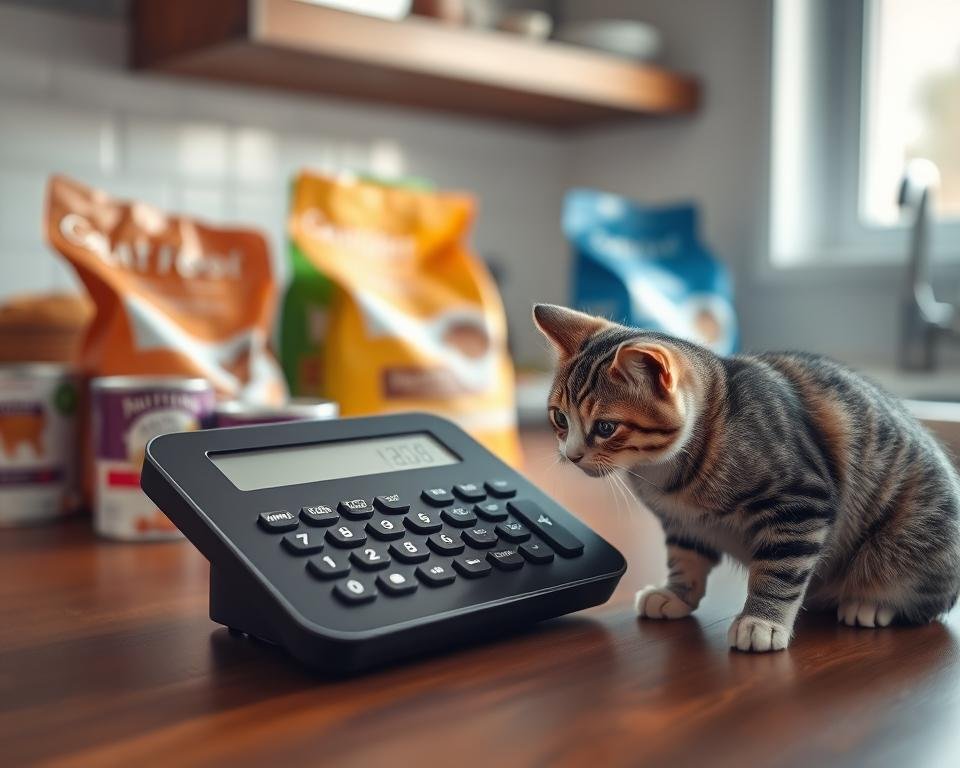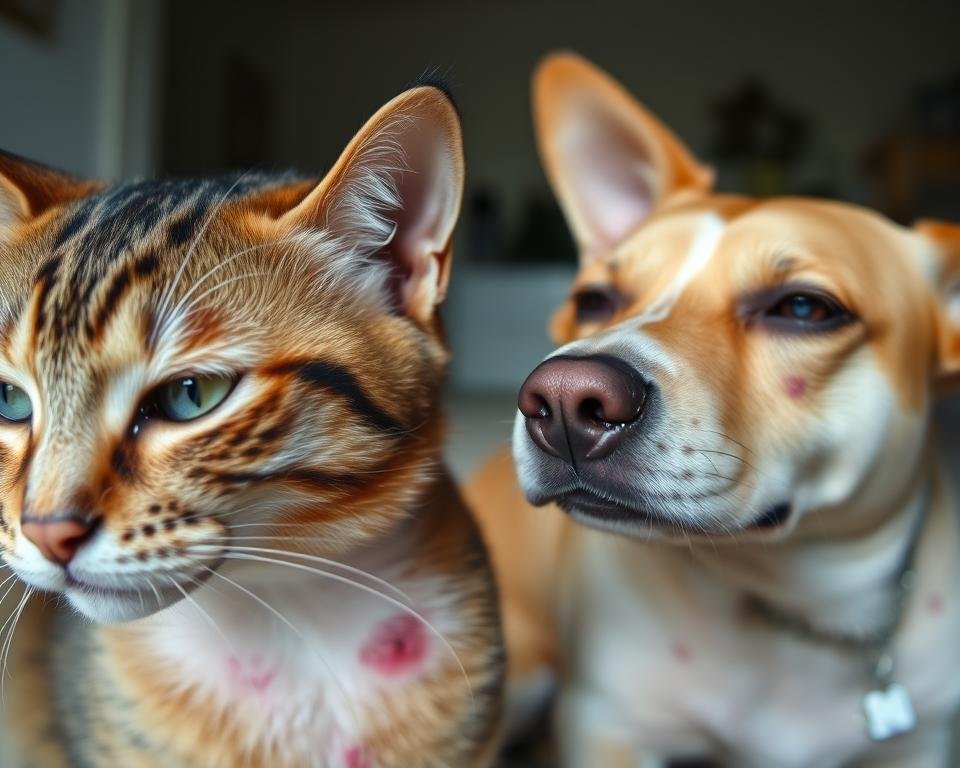Cat Food Calorie Calculator
Enter Your Cat’s Details
Results
It’s vital to make sure your cat gets the right food for their health. The cat food calculator is a great tool for this. It helps you figure out the perfect amount of food for your cat, whether it’s wet, dry, or both.
By knowing how many calories your cat’s food has and their activity level, you can use the calculator. This way, you can give your cat the nutrition they need.
The cat food calculator was made with help from “Podstawy żywienia psów i kotów” and “Nutritional Guidelines for Complete and Complementary Pet Food for Cats and Dogs”. This means the advice it gives is based on solid science and expert advice. It helps you make smart choices for your cat’s diet.
In this article, we’ll dive into the cat food calculator. We’ll cover how to find your cat’s food’s calorie content and their activity level. By the end, you’ll know how to make sure your cat gets the right nutrition for a happy, healthy life.
Understanding the Cat Food Calculator
To use a cat food calorie calculator well, you need to know a few key things. First, find out how many calories are in your cat’s food. This info is usually on the package as kcal/kg. If you can’t find it, you can guess by looking at the moisture, protein, fat, and fiber percentages.
It’s also vital to know how active your cat is. More active cats need more calories to keep up their energy. The calculator lets you choose your cat’s activity level. Then, it gives you a feeding plan that fits their needs.
Finding Calorie Content of Cat Food
Finding the calorie content of your cat’s food is the first step. This info is often on the package as kcal/kg. If you can’t find it, you can estimate by looking at the moisture, protein, fat, and fiber percentages.
Determining Your Cat’s Activity Level
Knowing your cat’s activity level is key for their calorie needs. The calculator will consider if your cat is inactive, has average activity, or is very active. Then, it will suggest a feeding plan that meets their energy needs.
“A cat’s resting energy requirement (RER) varies based on body weight, with, for example, a 9-pound cat requiring about 200 calories per day.”
Feeding Frequency: How Often Should Cats Eat?
Cats are naturally built to eat small meals often, like their wild ancestors. Giving them at least two meals a day, or even 3-6 smaller portions, is good. It helps keep them hydrated and lowers the chance of vomiting.
Benefits of Frequent Small Meals
Cats eating one big meal a day often vomit soon after. Their bodies aren’t made for big meals. But, eating smaller meals helps keep their water balance and digestive health better. Wet cat food, with more water, also helps keep them hydrated better than dry food.
Recommended Meal Schedules
Cats should eat at least two meals a day, but some might do better with 3-6 smaller meals. Less active cats need less food, while active ones need more. Using a digital scale to measure food helps give the right amount. Cups or scoops can give too much food, up to 80% more than needed.
“Cats should ideally eat at least two meals a day, but may benefit from more frequent meals, ranging from 3-6 times daily, based on their preferences.”
Cat Food Calculator Wet and Dry
Feeding your feline friend requires careful consideration of their dietary needs, especially when it comes to choosing between wet and dry food. A cat food calculator wet and dry can be a valuable tool for pet owners looking to determine the ideal portion sizes for their cats based on factors such as age, weight, and activity level. With a variety of options available, ensuring that your cat receives the right balance of nutrients is crucial for their overall health and well-being. This calculator can help you navigate the differences between wet and dry food, allowing you to make informed decisions about what to put in their bowl.
In addition to the basic caloric needs, many pet owners are becoming increasingly aware of the importance of carbohydrates in their cats’ diets. Utilizing a cat food carb calculator can help you understand the carbohydrate content of different food options and how it fits into your cat’s dietary requirements. Cats are obligate carnivores, and while they can handle some carbohydrates, excessive amounts may lead to health issues such as obesity and diabetes. By leveraging tools that assess both calorie and carbohydrate intake, you can provide a better feeding experience tailored specifically to your cat’s individual needs.
Another useful tool in this nutritional journey is the cat kcal calculator, which allows you to calculate the number of kilocalories your cat requires each day. These calculators often take into account factors like weight loss goals or weight maintenance, which are pivotal for cats that might need to shed some pounds. Feeding your cat the appropriate number of kilocalories can make a significant difference in their energy levels and overall health. Just like humans, an ideal balance of calories is paramount for maintaining a healthy lifestyle in cats.
Ultimately, understanding how to balance wet and dry food, carbohydrate intake, and caloric needs forms the foundation of a well-rounded diet for your pet. By integrating a cat food calculator wet and dry, along with a cat food carb calculator and cat kcal calculator, pet owners can ensure that their furry companions are not only full but also thriving. Investing time in understanding these aspects of feline nutrition will lead to happier, healthier cats and a stronger bond between pet and owner.
Wet vs. Dry Cat Food: Pros and Cons
Choosing between wet and dry cat food is a big decision for pet owners. Wet cat food has a lot of moisture, up to 78%. This is great for cats with health issues because it helps them stay hydrated. Dry cat food, with less moisture, is cheaper and easier to store.
Wet cat food is good for cats with obesity, diabetes, urinary problems, and kidney disease. The high moisture helps with these health issues. It’s also great for kittens because it’s softer and easier to chew.
Dry cat food has more calories because it’s made without moisture. This can lead to weight gain if not watched closely. But, it’s cheaper and doesn’t make a mess, which some owners like.
Choosing between wet and dry cat food depends on your cat’s needs and likes. Knowing the good and bad of each helps you pick the best food for your cat’s health and happiness.

Cat Food Calculator
The cat food calculator is a useful tool for finding the right food amount for your cat. You just need to know your cat’s weight, the food’s calorie content, and their activity level. It then gives you specific feeding advice to keep your cat healthy and active.
Calculating Ideal Portions
To use the cat food portion calculator, start by entering your cat’s weight. The calculator will then look at the food’s calorie content and your cat’s activity level. It will tell you the best cat food portions for your cat.
The how-to-use cat food calculator gives precise results. It considers your cat’s Resting Energy Requirement (RER) and Maintenance Energy Requirement (MER). This ensures your cat gets the right nutrients and calories for their health.
“The results from using calorie calculators or tables should be perceived as estimates only, with variations in metabolic rates that can alter figures by as much as 20%.”
Keep in mind, the cat food calculator is just a starting point. You might need to tweak the portions based on your cat’s unique needs and how they react. Regular checks and tweaks will help you find the best feeding routine for your cat.

Conclusion
The cat food calculator is a great tool for finding the perfect food portions for your cat. It helps you understand the food’s calorie content, your cat’s activity level, and their nutritional needs. This way, you can make sure your cat gets the right nutrients for their health and happiness.
Whether you give your cat wet, dry, or a mix of both, the calculator offers personalized advice. This helps you make smart choices about your cat’s diet.
With over 56.5 million cats in the U.S. that are overweight, it’s key to watch their calorie intake. Overweight cats are at risk for health problems like heart failure, skin issues, diabetes, and cancer. Using the cat food calculator can help keep your cat at a healthy weight and prevent these issues.
Proper cat nutrition is vital for your cat’s wellbeing. The cat feeding guide from the calculator can help you create a balanced diet for your cat. With the right information and tools, you can ensure your cat lives a long, healthy life by your side.
* Body conditions score are based on The Purina Body Condition System, source The Purina Institue



